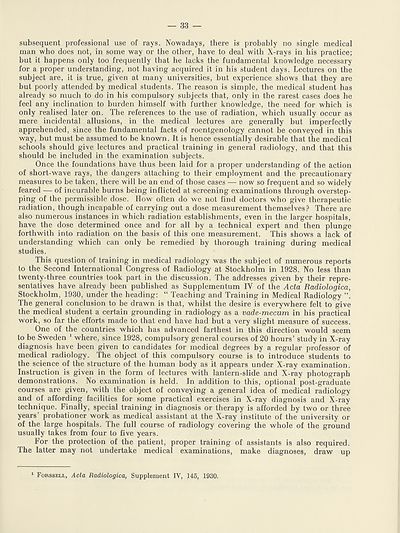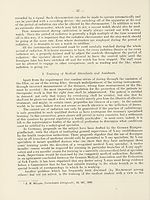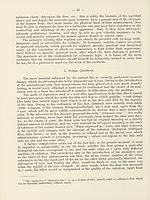Health > Protective measures against dangers resulting from the use of radium, roentgen and ultra-violet rays
(35)
Download files
Complete book:
Individual page:
Thumbnail gallery: Grid view | List view

33 —
subsequent professional use of rays. Nowadays, there is probably no single medical
man who does not, in some way or the other, have to deal with X-rays in his practice;
but it happens only too frequently that he lacks the fundamental knowledge necessary
for a proper understanding, not having acquired it in his student days. Lectures on the
subject are, it is true, given at many universities, but experience shows that they are
but poorly attended by medical students. The reason is simple, the medical student has
already so much to do in his compulsory subjects that, only in the rarest cases does he
feel any inclination to burden himself with further knowledge, the need for which is
only realised later on. The references to the use of radiation, which usually occur as
mere incidental allusions, in the medical lectures are generally but imperfectly
apprehended, since the fundamental facts of roentgenology cannot be conveyed in this
way, but must be assumed to be known. It is hence essentially desirable that the medical
schools should give lectures and practical training in general radiology, and that this
should be included in the examination subjects.
Once the foundations have thus been laid for a proper understanding of the action
of short-wave rays, the dangers attaching to their employment and the precautionary
measures to be taken, there will be an end of those cases — now so frequent and so widely
feared — of incurable burns being inflicted at screening examinations through overstep¬
ping of the permissible dose. How often do we not find doctors who give therapeutic
radiation, though incapable of carrying out a dose measurement themselves? There are
also numerous instances in which radiation establishments, even in the larger hospitals,
have the dose determined once and for all by a technical expert and then plunge
forthwith into radiation on the basis of this one measurement. This shows a lack of
understanding which can only be remedied by thorough training during medical
studies.
This question of training in medical radiology was the subject of numerous reports
to the Second International Congress of Radiology at Stockholm in 1928. No less than
twenty-three countries took part in the discussion. The addresses given by their repre¬
sentatives have already been published as Supplementum IV of the Acta Radiologica,
Stockholm, 1930, under the heading: “ Teaching and Training in Medical Radiology ”.
The general conclusion to be drawn is that, whilst the desire is everywhere felt to give
the medical student a certain grounding in radiology as a vade-mecum in his practical
work, so far the efforts made to that end have had but a very slight measure of success.
One of the countries which has advanced farthest in this direction would seem
to be Sweden 1 where, since 1928, compulsory general courses of 20 hours’ study in X-ray
diagnosis have been given to candidates for medical degrees by a regular professor of
medical radiology. The object of this compulsory course is to introduce students to
the science of the structure of the human body as it appears under X-ray examination.
Instruction is given in the form of lectures with lantern-slide and X-ray photograph
demonstrations. No examination is held. In addition to this, optional post-graduate
courses are given, with the object of conveying a general idea of medical radiology
and of affording facilities for some practical exercises in X-ray diagnosis and X-ray
technique. Finally, special training in diagnosis or therapy is afforded by two or three
years’ probationer work as medical assistant at the X-ray institute of the university or
of the large hospitals. The full course of radiology covering the whole of the ground
usually takes from four to five years.
For the protection of the patient, proper training of assistants is also required.
The latter may not undertake medical examinations, make diagnoses, draw up
1 Forssell, Acta Radiologica, Supplement IV, 145, 1930.
subsequent professional use of rays. Nowadays, there is probably no single medical
man who does not, in some way or the other, have to deal with X-rays in his practice;
but it happens only too frequently that he lacks the fundamental knowledge necessary
for a proper understanding, not having acquired it in his student days. Lectures on the
subject are, it is true, given at many universities, but experience shows that they are
but poorly attended by medical students. The reason is simple, the medical student has
already so much to do in his compulsory subjects that, only in the rarest cases does he
feel any inclination to burden himself with further knowledge, the need for which is
only realised later on. The references to the use of radiation, which usually occur as
mere incidental allusions, in the medical lectures are generally but imperfectly
apprehended, since the fundamental facts of roentgenology cannot be conveyed in this
way, but must be assumed to be known. It is hence essentially desirable that the medical
schools should give lectures and practical training in general radiology, and that this
should be included in the examination subjects.
Once the foundations have thus been laid for a proper understanding of the action
of short-wave rays, the dangers attaching to their employment and the precautionary
measures to be taken, there will be an end of those cases — now so frequent and so widely
feared — of incurable burns being inflicted at screening examinations through overstep¬
ping of the permissible dose. How often do we not find doctors who give therapeutic
radiation, though incapable of carrying out a dose measurement themselves? There are
also numerous instances in which radiation establishments, even in the larger hospitals,
have the dose determined once and for all by a technical expert and then plunge
forthwith into radiation on the basis of this one measurement. This shows a lack of
understanding which can only be remedied by thorough training during medical
studies.
This question of training in medical radiology was the subject of numerous reports
to the Second International Congress of Radiology at Stockholm in 1928. No less than
twenty-three countries took part in the discussion. The addresses given by their repre¬
sentatives have already been published as Supplementum IV of the Acta Radiologica,
Stockholm, 1930, under the heading: “ Teaching and Training in Medical Radiology ”.
The general conclusion to be drawn is that, whilst the desire is everywhere felt to give
the medical student a certain grounding in radiology as a vade-mecum in his practical
work, so far the efforts made to that end have had but a very slight measure of success.
One of the countries which has advanced farthest in this direction would seem
to be Sweden 1 where, since 1928, compulsory general courses of 20 hours’ study in X-ray
diagnosis have been given to candidates for medical degrees by a regular professor of
medical radiology. The object of this compulsory course is to introduce students to
the science of the structure of the human body as it appears under X-ray examination.
Instruction is given in the form of lectures with lantern-slide and X-ray photograph
demonstrations. No examination is held. In addition to this, optional post-graduate
courses are given, with the object of conveying a general idea of medical radiology
and of affording facilities for some practical exercises in X-ray diagnosis and X-ray
technique. Finally, special training in diagnosis or therapy is afforded by two or three
years’ probationer work as medical assistant at the X-ray institute of the university or
of the large hospitals. The full course of radiology covering the whole of the ground
usually takes from four to five years.
For the protection of the patient, proper training of assistants is also required.
The latter may not undertake medical examinations, make diagnoses, draw up
1 Forssell, Acta Radiologica, Supplement IV, 145, 1930.
Set display mode to:
![]() Universal Viewer |
Universal Viewer | ![]() Mirador |
Large image | Transcription
Mirador |
Large image | Transcription
Images and transcriptions on this page, including medium image downloads, may be used under the Creative Commons Attribution 4.0 International Licence unless otherwise stated. ![]()
| League of Nations > Health > Protective measures against dangers resulting from the use of radium, roentgen and ultra-violet rays > (35) |
|---|
| Permanent URL | https://digital.nls.uk/191800641 |
|---|
| Shelfmark | LN.III |
|---|---|
| Description | Over 1,200 documents from the non-political organs of the League of Nations that dealt with health, disarmament, economic and financial matters for the duration of the League (1919-1945). Also online are statistical bulletins, essential facts, and an overview of the League by the first Secretary General, Sir Eric Drummond. These items are part of the Official Publications collection at the National Library of Scotland. |
|---|---|
| Additional NLS resources: |
|

